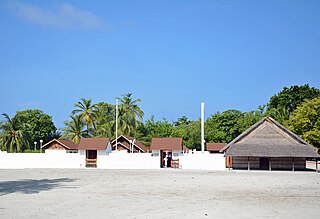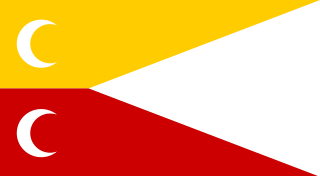
Sultan Haji Muhammad Imaaduddeen VI Iskandar was the sultan of the Maldives from 1893 to 1902. Sultan Imaaduddeen was born on 25 October 1868 to Prince Hassan Izzuddeen and Maandhoogey Dhon Didi. He was the younger half brother of Sultan Muhammad Mueenuddeen II [Kuda Bandaarain] and the grandson of Sultan Muhammad Imaduddeen IV of the Maldive islands. Despite being the eldest son of the latter, his father Prince Hassan Izzuddeen was removed from the line of succession on account of his blindness.
Sultan Muhammad Imaaduddeen V (1884–1920), son of Ibrahim Nooraddeen and Bodugaluge Didi of Machchangoalhi Ganduvaru, and also younger half-brother of Muhammad Shamsuddeen III, was the sultan of the Maldives from 1892 to 1893 for five months. He was 8 years old when he became the sultan, after the death of his father Sultan Ibrahim Nooraddeen. Despite having an older half-brother, Imaaduddeen V, was appointed as sultan by a decree of the Council of Ministers headed by Ibrahim Didi, brother-in-law to the late sultan Nooraddeen. Meanwhile, a vigorous protest was handed down to the Ceylon Governor in Colombo by Muhammed Didi, the brother of Kakaage Don Goma, one of the late Sultan Nooraddeen's wives highlighting that the Law of Succession in the Maldive Islands which supported lineal primogeniture has been breached and that his great-nephew Muhammed Shamsuddeen who was 14 and thus the eldest son of the late Sultan should be the legitimate heir to the throne. Five months later Imaaduddeen was deposed by Muhammad Shamsuddeen III as the Sultan of the Maldives. He died during his brother's reign.

Utheemu is one of the inhabited islands of Haa Alif Atoll administrative division and geographically part of Thiladhummathi Atoll in the north of the Maldives. It is an island-level administrative constituency governed by the Utheemu Island Council.
Muhammed Ghiya'as ud-din, the son of Sultan Ibrahim Iskandar II, was the sultan of the Maldives from 1766 to 1773. As per the will of his predecessor Dhon Bandaarain, Muhammed Manifufaanu ascended the throne and reigned as Sultan Al-Haj Muhammed Ghiya'as ud-din Iskandar Sri Kula Sundara Maha Radun. He was the last sultan of the Dhiyamigili Dynasty; he was deposed while away on a pilgrimage, and later, on his return trip he drowned, or was murdered by Kalhu Bandaarain.

The Utheemu dynasty was created in 1573 when Muhammad Thakurufaanu Al Auzam became sultan of the Maldives. The dynasty was named after the northern Maldives island of Utheemu, birthplace of Muhammad Thakurufaan. Muhammad Thakurufaan is considered a national hero, as he and his two brothers led a successful rebellion against the Portuguese and established his country's independence. Thirteen more sultans ruled during this dynastic period, which ended in 1697.
Abdulla, was crown prince of Dhiyamigili dynasty and the Maldives as the son of Sultan Muhammad Ghiyasuddin I of the Dhiyamigili dynasty.

The Kilwa Sultanate was a sultanate, centered at Kilwa, whose authority, at its height, stretched over the entire length of the Swahili Coast. According to the legend, it was founded in the 10th century by Ali ibn al-Hassan Shirazi, a Persian prince of Shiraz.
Al-Malik al-Mansur Sayf ad-Din Abu Bakr, better known as al-Mansur Abu Bakr, was a Bahri Mamluk Sultan of Egypt in 1341. From an early age, Abu Bakr received military training in the desert town of al-Karak. His father, Sultan an-Nasir Muhammad, groomed him as a potential successor to the throne and made him an emir in 1335. He was consistently promoted in the following years, becoming the na'ib (governor) of al-Karak in 1339. In June 1341, he became sultan, the first of several sons of an-Nasir Muhammad to accede to the throne. However, his reign was short-lived; in August, Abu Bakr was deposed and arrested by his father's senior emir, Qawsun. Abu Bakr was imprisoned in the Upper Egyptian city of Qus, along with many of his brothers, and executed on Qawsun's orders two months later. He was formally succeeded by his younger half-brother, al-Ashraf Kujuk, but Qawsun was left as the strongman of the sultanate.
Al-Sultana Khadeejah Sri Raadha Abaarana Mahaa Rehendhi or more famously known as just Rehendhi Khadeejah meaning, Queen Khadeejah, was the Sultana of the Maldives from 1347 to 1379. She was one of the few female rulers in the recorded history of Maldives.
Sultan Hassan Al-Hilaaly I, Sri Veera Bovana Mahaa Radhun was the first sultan to ascend the throne of Maldives from the Hilaalee dynasty by abolishing the dynasty which had ruled the Maldives for more than two centuries. He ascended the throne of The Maldives in 1388 and ruled for 10 years.
Amina I of the Maldives also called Amina Kabafaanu and Aminath Kabafan, was sultana regnant of the Maldives from 1753 until 1754. She also served as joint regent with her spouse Ali Shah Bandar Vela’ana’a Manikufa’anu in 1773 during the pilgrimage of her brother Sultan Muhammed Ghiya'as ud-din to Mecca.
Mariyam Kaba'afa'anu Rani Kilege was a Sultana consort of the Maldives by marriage to sultan Ibrahim Iskandar I of the Maldives. She served as regent of the Maldives during the minority of her son, sultan Kuda Muhammad of the Maldives, from 1687 until 1691.
Burecca of the Maldives or Buraki Rani, was a queen consort of the Maldives. She crowned her spouse Kalu Mohamed as king. She herself took the title rani instead of the title Rehendi or sultana, which was normally worn by female monarchs, signifying that she was queen consort rather than a monarch and ruler herself.
Asad al-Dīn Rumaythah ibn Muḥammad Abī Numayy al-Akbar al-Ḥasanī was Emir of Mecca seven times between 1301 and 1345.
‘Izz al-Dīn Abū Sarī‘ ‘Ajlān ibn Rumaythah ibn Muḥammad Abī Numayy al-Ḥasanī was Emir of Mecca from 1344 and 1372, with interruptions.

Several interregnums occurred in the history of the Maldives.
The caste system in the Maldives is the social stratification system found among the ethnic groups of the islands.



